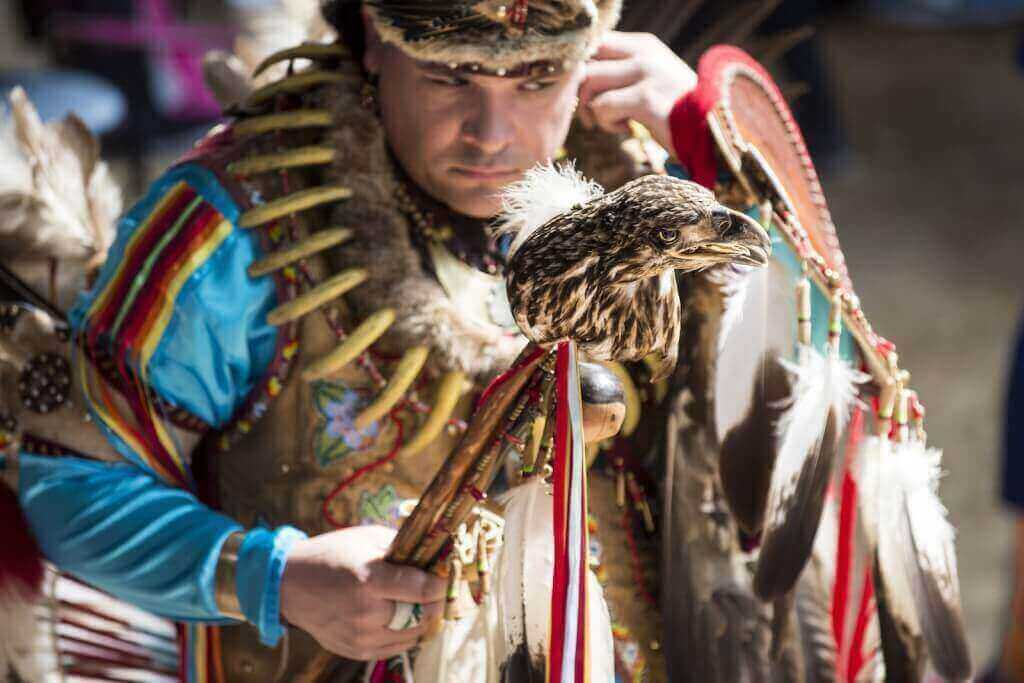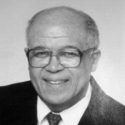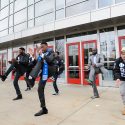Wunk Sheek and partners host 47th On Wisconsin Annual Spring Powwow

Head Dancer Joe Syrette, a member of the Ojibwe tribe from Batchewana, Ontario, holds an eagle head staff during the Spring Powwow held on campus in 2014. Photo: Jeff Miller
In 2015, more than 3,000 people took part in the On Wisconsin Annual Spring Powwow (OWASP), enjoying a Native American cultural experience that bridges the boundaries between the university and Wisconsin’s eleven tribal nations.
Now in its 47th year, the powwow provides an opportunity for the campus and surrounding community to participate in a contemporary native event, sharing and learning the culture of people indigenous to this area.
“We do the powwow to not only celebrate our culture but to open it up to the campus at large and really get non-natives immersed in native culture that they might otherwise not have access to,” says Bobbi Skenandore, a senior at the University of Wisconsin–Madison and a member of the Oneida Nation.
The 47th On Wisconsin Annual Spring Powwow takes place on Saturday and Sunday, April 2-3, at the Alliant Energy Center Arena in Madison. The event is free and open to the public. Doors will be open on Saturday from 10 a.m. to 10 p.m. and on Sunday from 10 a.m. to 7 p.m.
University Housing will provide free buses for UW–Madison students from the west and east sides of campus running every 30 minutes from 10 a.m. to 10 p.m. Parking at the Alliant Center is $7.
“We do the powwow to not only celebrate our culture but to open it up to the campus at large and really get non-natives immersed in native culture that they might otherwise not have access to.”
Bobbi Skenandore
Skenandore, originally from Chicago, is a member of Wunk Sheek, UW–Madison’s American Indian student organization, which hosts the powwow. Planning and working at the powwow helps native students connect to their culture while educating their fellow non-native students and community members.
Skenandore emphasizes the importance of Native American students being able to advocate for themselves and express their cultural identity while away at college. According to enrollment reports, only 387 out of over 43,000 UW–Madison students identified as Native American (not counting Native Hawaiians) during the Fall 2015 semester.
“Because we’re a minority, we don’t have a big campus population, so sometimes our culture is the only thing we have,” says Skenandore, who is earning a certificate in American Indian studies as well as majoring in environmental studies and nonprofit leadership. “We need to celebrate it; otherwise, you can just feel lost.”
Powwows also play an integral role in uniting native culture from the upper Midwest — Minnesota, South Dakota, Iowa and even Canada — especially for students originally from native communities, where they are surrounded by their culture.
“Because we’re a minority, we don’t have a big campus population, so sometimes our culture is the only thing we have.”
Bobbi Skenandore
“It’s a community gathering for strength, reflection and sharing, as well as a way to re-center for many people,” says Christopher Kilgour, program manager for the UW–Madison Tribal Technology Institute (TTI).
Native American students will also form a critical mass in Madison while attending the annual TTI Conference and Wisconsin Indian Education Association Conference during the same weekend.
“This will make it possible to not only expose students to events and activities on campus, but also put them in contact with other native students from all over the state who are involved in education,” says Kilgour. “This is a totally different world. For some students, powwow may be the only time they see other community members.”
Participants and visiting tribal members play a huge role in making the powwow a welcoming event, sharing plenty of celebratory activities and good food. Masters of ceremonies will keep the crowd engaged and informed, explaining what’s happening throughout the Grand Entry and the dancing that follows.
Some highlights:
- Six main styles of exhibition dancing include men’s and women’s traditional and fancy styles, as well as men’s grass and women’s jingle styles. Audience members are invited to take part in intertribal dancing, open to everyone.
- More than 20 traditional and contemporary American Indian art vendors will exhibit.
- Traditional native foods available include wild rice soup, venison dishes, Indian tacos and fry bread.
- In an interactive Kids Activity Area, children can learn about the Three Sisters, a southeastern United States agricultural tradition of growing beans, corn and winter squash together. They’ll learn the science behind why these three crops grow well together, as well as sustainable agricultural and wildlife management and the importance of tribal sovereignty.
- The Great Lakes Indian Fish and Wildlife Commission (GLIFWC) hosts other learning adventures, including live introductions of invasive animal species like lampreys. The Raptor Education Group, Inc., (REGI) will discuss hawks on Sunday, with several dancers discussing regalia and appropriate usage of feathers.
- The Ho-Chunk and Mohican Nation Color Guards, followed by the Head Staff, will lead the Grand Entry, which occurs at 1 p.m. and 7 p.m. on Saturday and at 1 p.m. on Sunday.
Nationally recognized dancers, drummers and staff participating in the OWASP 2016 include: Blackstone Host Drum (Sweetgrass First Nations-Canada), Youth Host Hay Creek (Lac Courte Oreilles), Co-host Pipestone (Lac Courte Oreilles), Co-Host Ho-Chunk Station (Ho-Chunk/Potawatomi), Head Man Stewart Boivin (Menominee), Head Lady Grace Pushetonequa (Meskwaki), Junior Head Man Brevin Boyd (Lakota/Potawatomi), Junior Head Lady Symone Pemma (Potawatomi), Master of Ceremonies Dylan Prescott (Ho-Chunk/Potawatomi), Isaiah Stewart (Oglala Lakota) and Gerald Cleveland (Ho-Chunk), and Arena Director Randy Paskemin (Sweetgrass First Nations-Canada).
Co-sponsors include Native American student groups at UW–Madison, including Wunk Sheek, Alpha Pi Omega Sorority, the American Indian Science and Engineering Society and the Division of Diversity, Equity & Educational Achievement’s Pathways Program.
Tags: diversity, outreach, student life



